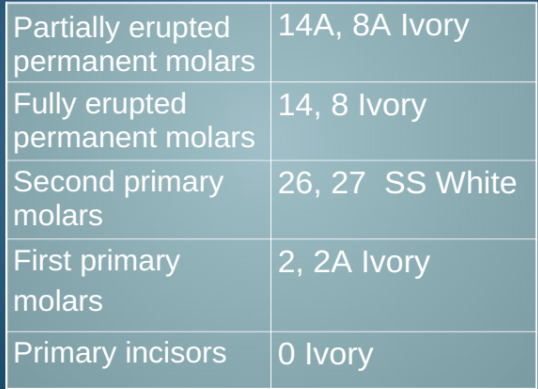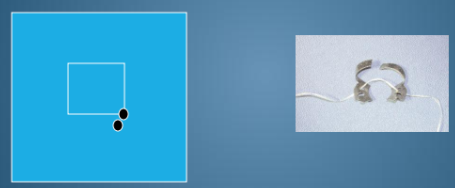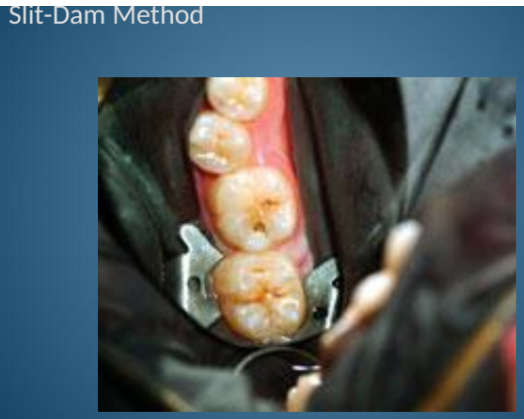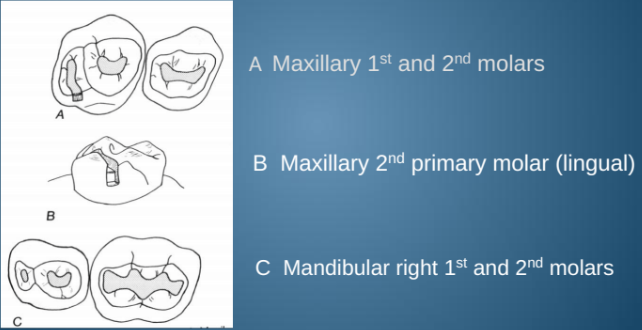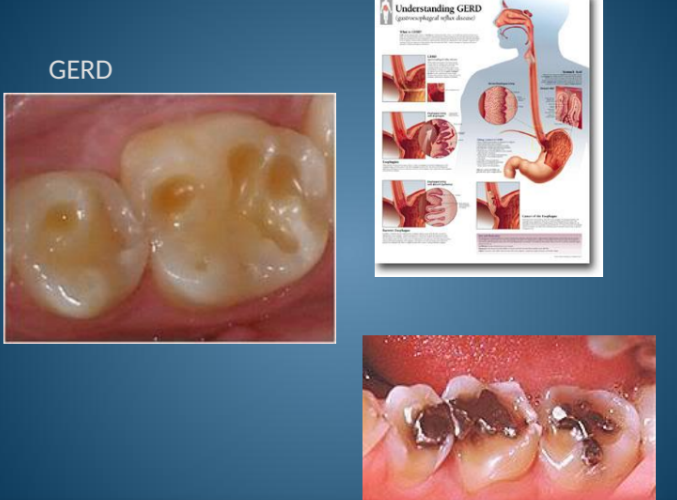
Restorative Dentistry for children
Objectives
Review pediatric restorative techniques from sophomore lab.
Provide knowledge for restorative procedures during Junior Pediatric experience.
Discuss restorative dentistry in the context of pediatric dental care.
Formulate pediatric treatment plans.
Historically management of dental caries in children has involved clinical and radiographic identification of carious lesions followed by surgical intervention to remove and restore affected enamel and dentin
Current evidence regarding caries process and risk assessment allows clinician to go beyond traditional surgical management
Therapy should focus on patient-specific approaches that include disease monitoring and preventive therapies supplemented when necessary with restorative care.
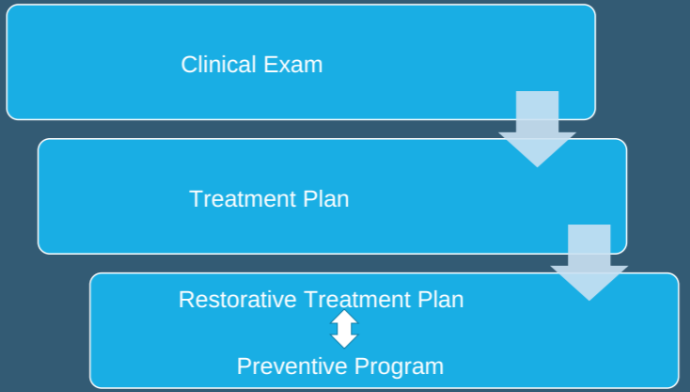
Restorative Tx-objectives
Repair or limit damage from caries
Protect & preserve tooth structure
Reestablish adequate function
Restore esthetics (where applicable)
Provide ease in maintaining good OH
Provide child with a good experience
Dental Disability
Dental caries, periodontal disease and other oral conditions left untreated can substantially limit a child’s participation in life activities
A child is considered to have a dental disability if pain, infection or lack of functional dentition
Restricts nutritional intake for growth and energy needs
Delays or otherwise alters growth &development
Inhibits participation in life activities
Isovac
Children may struggle with the isovac for long durations.
Sizes available: Pedo, XS, S, M, L.
Size selection based on finger fit between front teeth for appropriate sizing.
If I can barely fit my 3 fingers in between their front teeth– Pedo
3 fingers fit comfortably – S
The Raincoat
Improves access and visualization = saves time
Superior moisture control
Prevents aspiration or swallowing of foreign bodies
Protects soft tissues
Aids behavior management
Child becomes nasal breather
Helps dentist educate parents
Option when child cannot tolerate the isovac system.
Clamp Selection
Technique Tips
Visualize a 1 inch square in the middle of the 5 x 5 dam with each corner indicating the punch hole for the clamp bearing tooth
Holes too far apart will make it difficult to fit interproximally and may cause problems in Cl II preps
holes too close will result in leakage
Do not include more holes than necessary to isolate area
Considerations in Primary Dentition Restoration
Material
Patient’s age
Influences ability to co-op
Durability of restoration
Caries risk
Cooperation
Behavior may not be conducive to perfect, textbook cavity preparation & restoration
Morphology of primary teeth
Parental wishes
Nickel Allergy
ALLERGIC CONTACT DERMATITIS OCCURRED ONE WEEK AFTER PLACEMENT
IN PEDIATRIC DENTISTRY, IT IS COMMON TO USESTAINLESS STEEL CROWNS, WHICH CONTAIN 8 -13% NICKEL. THEIR USE IS CONTRAINDICATED INPATIENTS WITH KNOWN NICKEL ALLERGIES.SYMPTOMS DISAPPEARED AFTER CROWNREMOVED.ALLERGIC CONTACT DERMATITIS OCCURRED ONE WEEK AFTER
Morphologic Differences of Primary Teeth
Mesiodistal diameter of primary molar crown > cervico oclusal dimension
Buccal & lingual surfaces converge toward occlusal
Enamel & dentin are thinner
Cervical enamel rods slope occlusally
Pulp chambers are proportionately larger & closer to surface
Contacts are broad & flat
Shorter clinical crown heights
Greater cervical constriction
Outline form review
Bur Selection
efficiency & convenience
Single bur in most situations
Round-end, pear shape329, 330, 245 and 256
Incipient Class I Cavity - Very Young Child
Child under 2 years of age
Small cavity preparation made without the aid of the rubber dam or local anesthetic
Objective is to restore the tooth with amalgam to arrest decay and to prevent further tooth destruction without a lengthily or involved dental appointment
Anatomy of pit and fissure Caries
Enamel undermined by caries but strengthened by fluorides also makes detection of diseased dentin more difficult
The explorer is often of limited use in detection of pit and fissure caries, since fissures are often narrower than the explorer tip.
Preventive Resin Restoration
AKA Sealed Composite Resin Restoration
Young permanent teeth with small Class I caries
Contraindications
BWX revealing Class II caries
extensive caries
Inability to adequately isolate
Downside
Success is dependent on keeping sealant intact
Class II Cavity Preparations
1.5 mm (check DL of axiopulpal line angle)
Translates to .5mm into dentin
1/3 intercuspal distance
Gingival seat and proximal walls break contact
> B-L extension at cervical
No reverse curves, no bevels
No MO’s on first primary molars !
Amalgam vs. Composite Resins
Amalgam:
Amalgam use was common and supported by the evidence from clinical trials
Success rate for Class II amalgams is reported to be between 70-80%
Indications
Children who are at moderate caries risk, or who are not totally co-op (i.e. moisture control is a problem)
Composite Resins:
Clinical studies would suggest that class II composites in primary molars are only moderately durable (40% after 6 years)Recent advances are showing improved success with resin-based composites
Biggest problem is integrity of the bond at the depth of the proximal box
Isolation is a must
Incremental condensation
Esthetic advantages of resin-based restorations are outweighing the increased expense in time and materials
Contraindications
Where a tooth cannot be isolated to obtain moisture and or hemorrhage control
Where large, multisurface restorations are required in the primary dentition
High-risk patients
Gerd
Small Conventional Class III
Mandibular Incisors: retention of Class III is questionable. “Disking” of proximal surface, opening up contact and removing the cavitation, followed by topical Fl.
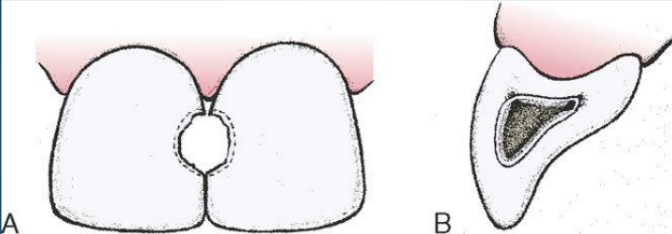
Class III Cavity-Incisors
Guidelines for Treatment Planning
Initial appointment should be short and manageable.
Last restorative appointment requires minimal effort.
Use quadrant dentistry when possible.
Avoid bilateral mandibular blocks.
Parent Education on SDF (Silver Diamine Fluoride)
Used to halt tooth decay and alleviate sensitivity.
Application procedure:
Dry the area.
Apply SDF.
Allow to dry for one minute, then rinse.
Limitations to SDF:
Darkens affected areas permanently.
Requires continuation of dental fillings or crowns for functional restoration.
Molar Incisor Hypomineralization (MIH)
Etiology
Factors include prenatal illness, low birth weight, and exposure to certain toxins.
Permanent molars and incisors uniquely affected during development.
Treatment Strategies by Severity
Mild:
Maintain function and preserve tooth structure.
Moderate:
Aesthetic treatments and resin restorations may be needed.
Severe:
Use of stainless steel crowns preferred; possible extraction of severely impacted molars.
Radiography Guidelines
Prescribe radiographs judiciously to minimize radiation exposure.
Consider the child's dental development stage and caries risk in decision-making.
Restorative Dentistry for children
Objectives
Review pediatric restorative techniques from sophomore lab.
Provide knowledge for restorative procedures during Junior Pediatric experience.
Discuss restorative dentistry in the context of pediatric dental care.
Formulate pediatric treatment plans.
Historically management of dental caries in children has involved clinical and radiographic identification of carious lesions followed by surgical intervention to remove and restore affected enamel and dentin
Current evidence regarding caries process and risk assessment allows clinician to go beyond traditional surgical management
Therapy should focus on patient-specific approaches that include disease monitoring and preventive therapies supplemented when necessary with restorative care.

Restorative Tx-objectives
Repair or limit damage from caries
Protect & preserve tooth structure
Reestablish adequate function
Restore esthetics (where applicable)
Provide ease in maintaining good OH
Provide child with a good experience
Dental Disability
Dental caries, periodontal disease and other oral conditions left untreated can substantially limit a child’s participation in life activities
A child is considered to have a dental disability if pain, infection or lack of functional dentition
Restricts nutritional intake for growth and energy needs
Delays or otherwise alters growth &development
Inhibits participation in life activities
Isovac
Children may struggle with the isovac for long durations.
Sizes available: Pedo, XS, S, M, L.
Size selection based on finger fit between front teeth for appropriate sizing.
If I can barely fit my 3 fingers in between their front teeth– Pedo
3 fingers fit comfortably – S
The Raincoat
Improves access and visualization = saves time
Superior moisture control
Prevents aspiration or swallowing of foreign bodies
Protects soft tissues
Aids behavior management
Child becomes nasal breather
Helps dentist educate parents
Option when child cannot tolerate the isovac system.
Clamp Selection
Technique Tips
Visualize a 1 inch square in the middle of the 5 x 5 dam with each corner indicating the punch hole for the clamp bearing tooth
Holes too far apart will make it difficult to fit interproximally and may cause problems in Cl II preps
holes too close will result in leakage
Do not include more holes than necessary to isolate area
Considerations in Primary Dentition Restoration
Material
Patient’s age
Influences ability to co-op
Durability of restoration
Caries risk
Cooperation
Behavior may not be conducive to perfect, textbook cavity preparation & restoration
Morphology of primary teeth
Parental wishes
Nickel Allergy
ALLERGIC CONTACT DERMATITIS OCCURRED ONE WEEK AFTER PLACEMENT
IN PEDIATRIC DENTISTRY, IT IS COMMON TO USESTAINLESS STEEL CROWNS, WHICH CONTAIN 8 -13% NICKEL. THEIR USE IS CONTRAINDICATED INPATIENTS WITH KNOWN NICKEL ALLERGIES.SYMPTOMS DISAPPEARED AFTER CROWNREMOVED.ALLERGIC CONTACT DERMATITIS OCCURRED ONE WEEK AFTER
Morphologic Differences of Primary Teeth
Mesiodistal diameter of primary molar crown > cervico oclusal dimension
Buccal & lingual surfaces converge toward occlusal
Enamel & dentin are thinner
Cervical enamel rods slope occlusally
Pulp chambers are proportionately larger & closer to surface
Contacts are broad & flat
Shorter clinical crown heights
Greater cervical constriction
Outline form review
Bur Selection
efficiency & convenience
Single bur in most situations
Round-end, pear shape329, 330, 245 and 256
Incipient Class I Cavity - Very Young Child
Child under 2 years of age
Small cavity preparation made without the aid of the rubber dam or local anesthetic
Objective is to restore the tooth with amalgam to arrest decay and to prevent further tooth destruction without a lengthily or involved dental appointment
Anatomy of pit and fissure Caries
Enamel undermined by caries but strengthened by fluorides also makes detection of diseased dentin more difficult
The explorer is often of limited use in detection of pit and fissure caries, since fissures are often narrower than the explorer tip.
Preventive Resin Restoration
AKA Sealed Composite Resin Restoration
Young permanent teeth with small Class I caries
Contraindications
BWX revealing Class II caries
extensive caries
Inability to adequately isolate
Downside
Success is dependent on keeping sealant intact
Class II Cavity Preparations
1.5 mm (check DL of axiopulpal line angle)
Translates to .5mm into dentin
1/3 intercuspal distance
Gingival seat and proximal walls break contact
> B-L extension at cervical
No reverse curves, no bevels
No MO’s on first primary molars !
Amalgam vs. Composite Resins
Amalgam:
Amalgam use was common and supported by the evidence from clinical trials
Success rate for Class II amalgams is reported to be between 70-80%
Indications
Children who are at moderate caries risk, or who are not totally co-op (i.e. moisture control is a problem)
Composite Resins:
Clinical studies would suggest that class II composites in primary molars are only moderately durable (40% after 6 years)Recent advances are showing improved success with resin-based composites
Biggest problem is integrity of the bond at the depth of the proximal box
Isolation is a must
Incremental condensation
Esthetic advantages of resin-based restorations are outweighing the increased expense in time and materials
Contraindications
Where a tooth cannot be isolated to obtain moisture and or hemorrhage control
Where large, multisurface restorations are required in the primary dentition
High-risk patients
Gerd
Small Conventional Class III
Mandibular Incisors: retention of Class III is questionable. “Disking” of proximal surface, opening up contact and removing the cavitation, followed by topical Fl.

Class III Cavity-Incisors
Guidelines for Treatment Planning
Initial appointment should be short and manageable.
Last restorative appointment requires minimal effort.
Use quadrant dentistry when possible.
Avoid bilateral mandibular blocks.
Parent Education on SDF (Silver Diamine Fluoride)
Used to halt tooth decay and alleviate sensitivity.
Application procedure:
Dry the area.
Apply SDF.
Allow to dry for one minute, then rinse.
Limitations to SDF:
Darkens affected areas permanently.
Requires continuation of dental fillings or crowns for functional restoration.
Molar Incisor Hypomineralization (MIH)
Etiology
Factors include prenatal illness, low birth weight, and exposure to certain toxins.
Permanent molars and incisors uniquely affected during development.
Treatment Strategies by Severity
Mild:
Maintain function and preserve tooth structure.
Moderate:
Aesthetic treatments and resin restorations may be needed.
Severe:
Use of stainless steel crowns preferred; possible extraction of severely impacted molars.
Radiography Guidelines
Prescribe radiographs judiciously to minimize radiation exposure.
Consider the child's dental development stage and caries risk in decision-making.
